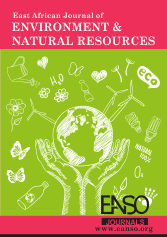Contribution of Improved Cook Stoves to the reduction of wood fuel consumption in Rutsiro District, Rwanda
Ikisiri
This study aimed to examine the contribution of Improved Cook Stoves (ICS) in reducing wood fuel consumption in Rutsiro District, Rwanda. The research focused on three specific objectives: identifying the level of ICS utilization, assessing the reduction in wood fuel consumption and finding out whether there is any relationship between ICS usage and wood fuel consumption. A mixed-methods approach was adopted, incorporating both quantitative and qualitative research designs. The study targeted over 28,555 households in five sectors near Gishwati-Mukura forests in Rutsiro District, and 395 households were selected as sample size through Yamane’s formula and stratified random sampling technique. Data were collected using questionnaires and documentary review and data were analyzed with SPSS software, employing descriptive and inferential statistics, including multiple linear regression. Analysis using descriptive statistics and multiple linear regression revealed that household characteristics (mean = 4.32), awareness levels (mean = 4.50), and stove quality (mean = 4.31) had a statistically significant and positive impact on reducing wood fuel consumption. However, stove cost, despite a high average score (mean = 4.45), did not show a significant effect. These factors were found to be more important than the stove cost, which was perceived as high but did not significantly affect fuel reduction. This highlights the crucial role of awareness, stove quality, and behavioural factors in the adoption and success of ICS. The study concluded that addressing the financial barrier to stove adoption, while important, is less significant than improving public awareness, stove quality, and behavioural change. The study recommended that the government and development partners prioritize awareness campaigns to promote the benefits of ICS. Additionally, financial incentives, subsidies, and better access to affordable payment options should be introduced to make ICS more accessible
Upakuaji
Marejeleo
Barry, J. (2007). Environment and Social Theory. 2nd ed. London: Routledge
Chepkurui, L, Makori M. (2016). Drivers Of Utilization Of Improved Energy Saving Cooks Toves Projects in Kenya: A Case Of Bomet County. The Strategic Journal of Business and Change Management
Čukić, I., Kypridemos, C., Evans, A. W., Pope, D., & Puzzolo, E. (2021). Towards Sustainable Development Goal 7 “Universal Access to Clean Modern Energy”: National Strategy in Rwanda to Scale Clean Cooking with Bottled Gas. Energies, 14(15), 4582.
Gebreegziabher, Z., Mekonnen, A., Kassie, M., and Köhlin, G. (2010). Household tree planting in Tigrai, Northern Ethiopia: Tree species, purposes, and determinants.
Githiomi, J. (2021). Factors influencing adoption of biomass energy conservation technologies in selected areas of Kitui Country, Kenya.
Iyakaremye, J. D., Harerimana, L. , Deepak Das , Mugwaneza, F. and Ndikubwimana, J. B. (2019). Evaluation and comparison of the developed types of burnt clay stoves so as to find out the fuel efficient stove to recommend to rural households. East African Journal of Science and Technology, Vol.9 Issue1, 2019
Kelly. R. M. (2015). The use of improved technology and market-based incentives to increase forest resource and biodiversity conservation in Rwanda (Master’s thesis, University of Kentucky). University of Kentucky
Kristin Aunan, and Eva A. Rehfuess. (2017). Liquefied Petroleum Gas as a Clean Cooking Fuel for Developing Countries: Implications for Climate, Forests, and Affordability. Materials on Development Financing No. 7. Frankfurt: KfW Development Bank
Kombo, D. K., and Tromp, D. L. A. (2006). Project and Thesis Writing: An Introduction. Pauline’s Publications Africa
Kothari, C. R. (2018). Research methodology: Methods and techniques (2nd ed.). New Delhi, India: New Age International (P) Limited.
Lewis, J. J., and Pattanayak, S. K. (2019). Who adopts improved fuels and cookstoves? A systematic review. Environmental health perspectives, 120(5), 637-645.
Ministry of Energy (MoE). (2022). Study on Kenya’s Energy Demand, Supply and Policy Strategy for Households, Small scale Industries and Service Establishments. Kamfor Consultants, Nairobi, Kenya.
Mwawura, A.W. (2020). Assessing contribution of improved Cook stove in reducing woodfuel consumption in Kenya. Case study of Public Secondary schools in Machakos County. Unpublished Thesis, University of Nairobi.
Newing H (2011) Conducting research in conservation: a social science perspective. Abingdon and New York: Routledge.
NISR, N.I & WFP. (2019). Comprehensive Food Security and Vulnerability Analysis (CFSVA). Kigali: NISR
Nshimiyimana, A. (2021). Socio-Economic Determinants for Household Uptake of Modern Energy Technologies: Evidence From Rwanda Panel Data, Unpublished thesis, University of Rwanda
Puzzolo, E., Stanistreet, D., Pope, D., and Bruce, N. G. (2014). Enablers and barriers to large scale uptake of improved solid fuel stoves: a systematic review. Environmental health perspectives, 122(2), 120-130.
Rayens, K. M. (2015). The use of improved technology and market-based incentives to increase forest resource and biodiversity conservation in Rwanda (Master’s thesis, University of Kentucky). University of Kentucky Institutional Repository.
Rubabaza S. (2019). Firewood Utilization and Environmental Degradation: A Case Study of Musanze District Of Rwanda, Unpublished thesis, University of Rwanda.
Ruiz-Mercado,I., Masera,O.Zamora,H. and Smith,K.R. (2011). Adoption and sustained use of improved cookstoves. Energy polcy,39(12), 7557-7566.
Rutsiro District (2018): District strategy plan (2018-2024).
Smith, K. R., Bruce, N., Balakrishnan, K., Adair-Rohani, H., Balmes, J., Chafe, Z., and Rehfuess, E. (2014). Millions dead: how do we know and what does it mean? Methods used in the comparative risk assessment of household air pollution. Annual review of public health, 35, 185-206.
Steve, W. (2020) Global wood fuel standards. Journal 14. No. 4, pg 43-55
Wickman, P. O. (2006). Aesthetic experience in science education: Learning and meaning-making as situated talk and action. Lawrence Erlbaum Associates.
Yaman, T. (1967). Statistics, An introductory analysis (2nd ed.). New York: Harper and Row.
Copyright (c) 2025 Pacifique Isimbi, Eric Sibomana, PhD

This work is licensed under a Creative Commons Attribution 4.0 International License.




























